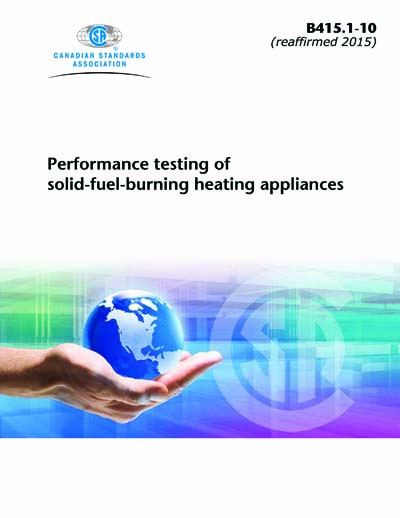Historical
CSA B415.1-10 (R2020)
Performance testing of solid-fuel-burning heating appliances
Preface This is the third edition of CSA B415.1, Performance testing of solid-fuel-burning heating appliances. It supersedes the previous editions, published in 2000 under the same title, and published in 1992 under the title Performance Testing of Solid-Fuel-Burning Stoves, Inserts, and Low-Burn-Rate Factory-Built Appliances. Scope 1.1 This Standard specifies requirements for performance testing of solid-fuel-burning heating appliances, including maximum emission rates. 1.2 This Standard specifies a method for determining (a) heat outputs (b) appliance efficiencies (c) emission levels and composition and (d) flue gas flow rates. 1.3 This Standard applies to (a) manually and automatically fuelled stoves and fireplace inserts (b) factory-built fireplaces with a minimum burn rate less than 5 kg/h (11 lb/h), as determined in accordance with Clause 7 and (c) furnaces and hydronic heaters designed to have the useful heat produced by the appliance conveyed to areas remote from the appliance by ducting or plumbing. Note: Typically, units tested under this Standard will have outputs less than 150 kW (500 000 Btu/h). For the purposes of this Standard, solid-fuel-burning appliances include manually and automatically fuelled systems (including add-ons and combinations). 1.4 This Standard covers appliances that burn biomass fuels such as (a) cordwood (b) wood chips (c) sawdust (d) firelogs (e) wood, paper, and other biomass pellets and briquettes and (f) kernel corn and other grains. This Standard does not cover coal-fired appliances. 1.5 This Standard does not apply to (a) site-built masonry fireplaces (b) site-built masonry heaters or (c) factory-built fireplaces with a minimum burn rate greater than or equal to 5 kg/h (11 lb/h). 1.6 The values given in SI units are the units of record for the purposes of this Standard. The values given in parentheses are for information and comparison only. 1.7 In CSA standards, "shall" is used to express a requirement, i.e., a provision that the user is obliged to satisfy in order to comply with the standard; "should" is used to express a recommendation or that which is advised but not required; and "may" is used to express an option or that which is permissible within the limits of the standard. Notes accompanying clauses do not include requirements or alternative requirements; the purpose of a note accompanying a clause is to separate from the text explanatory or informative material. Notes to tables and figures are considered part of the table or figure and may be written as requirements. Annexes are designated normative (mandatory) or informative (nonmandatory) to define their application.
CSA America, Inc. [csa]

